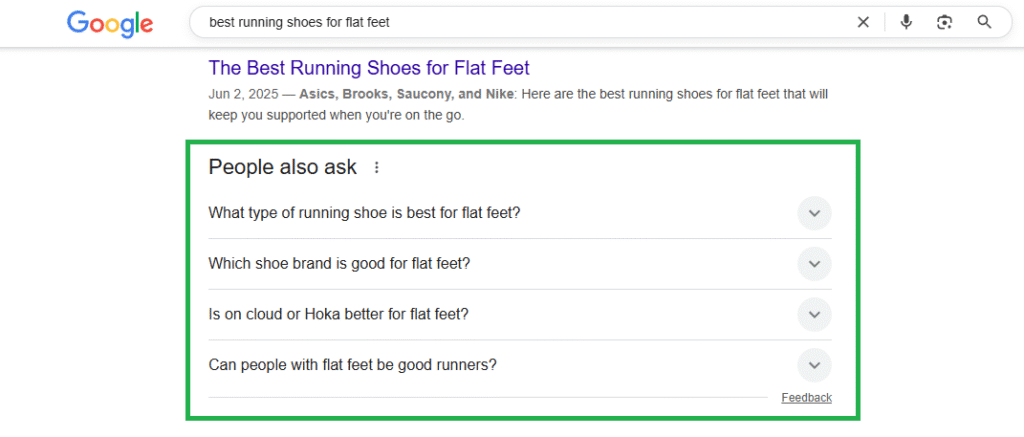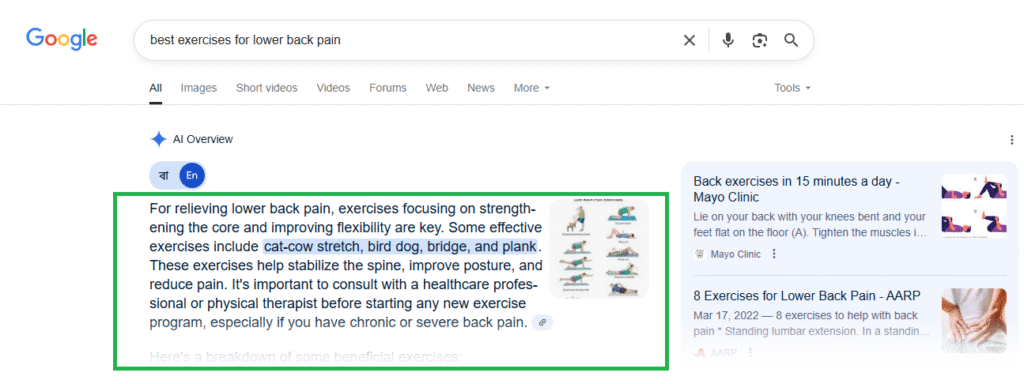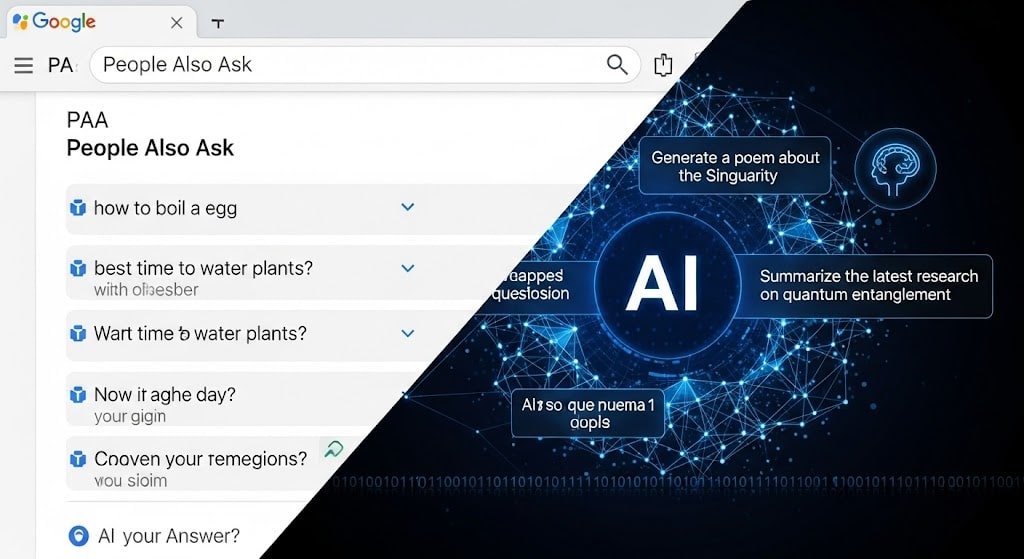Over the past decade, Google’s search results pages (SERPs) have gone from a simple list of ten blue links to a dynamic, AI-driven experience. Features like Featured Snippets, Knowledge Panels, and People Also Ask (PAA) have transformed how users consume information.
Now, with the introduction of Google AI Overviews (previously called Search Generative Experience, or SGE), we’re entering a new era of search — one that combines AI summarization with traditional ranking signals.
The big question for SEO professionals is: What happens to PAA when AI Overviews take center stage? And how should we adapt?
What is People Also Ask (PAA)?
People Also Ask (PAA) is a dynamic search feature in Google’s results that shows a list of related questions based on the user’s query. Each question can be expanded to reveal a short, snippet-like answer, usually pulled directly from a relevant webpage, along with a link to the source.
This feature was first introduced in 2015 as part of Google’s effort to help users discover related information more efficiently. Since then, it has become one of the most common SERP elements, appearing in over 50% of search results according to SEO industry studies.
How PAA Works
- Trigger: When you search for a keyword, Google’s algorithms analyze related queries from its database and user search patterns.
- Display: A PAA box appears, typically near the top or middle of the results.
- Interaction: Clicking on a question expands the answer and often triggers additional related questions to appear.
- Source: Each answer is extracted from a web page that Google considers relevant and trustworthy for that specific question.
Key Features of PAA
- Expandable Questions: Clicking one question often reveals more.
- Endless Scrolling Effect: The more you click, the more new related questions appear.
- Diverse Query Coverage: PAA can cover informational, navigational, and even transactional questions.
- Dynamic Placement: PAA might appear near the top for some queries and further down for others.
Why PAA Matters for SEO
- Visibility Without Ranking #1: You can appear in PAA even if your page isn’t in the top organic position.
- Long-Tail Keyword Targeting: PAA often features specific, niche questions with high conversion potential.
- Authority Building: Consistently appearing in PAA can boost your brand credibility.
- Traffic Opportunities: Well-optimized answers can entice users to click through to your site for more details.
✅ Example:
Search for “best running shoes for flat feet” and you might see questions like:

If your website answers these questions directly and clearly, you have a chance to win those PAA spots — even if you’re not ranked at the very top for the main keyword.
What are AI Overviews?
AI Overviews are Google’s newest search feature, powered by generative AI, that delivers a concise, AI-written summary of a topic directly at the top of the search results. Instead of simply listing web pages, AI Overviews synthesize information from multiple sources to give users a comprehensive, quick-to-read answer — often without requiring them to click through to another site.
This feature is part of Google’s Search Generative Experience (SGE) initiative, which aims to make search more conversational, context-aware, and capable of handling complex queries. In 2024, Google officially started rolling out AI Overviews to a wider audience in the U.S. and other selected markets.
How AI Overviews Work
- User Query Analysis: Google interprets the question, determining if it would benefit from a synthesized answer.
- Content Gathering: The AI scans its index for the most relevant, authoritative, and recent sources.
- Summary Generation: It generates a natural-language answer that blends key points from these sources.
- Citations Displayed: Links to the original sources are included, often within the text or in a separate “sources” panel.
Key Features of AI Overviews
- Position: Always displayed at or near the very top of the SERP, above Featured Snippets and PAA.
- Format: One or more paragraphs of AI-generated text, sometimes accompanied by bullet points, images, or product suggestions.
- Multiple Citations: Instead of highlighting a single source, AI Overviews cite multiple websites for credibility.
- Complex Query Handling: Ideal for multi-part questions or research-style searches.
Why AI Overviews Matter for SEO
- Prime Real Estate: Being featured here puts your content in the first thing users see.
- Traffic Potential — and Risk: If your site is cited, you could gain clicks. But if the AI answer fully satisfies the query, users may never click through.
- Authority Requirement: AI Overviews tend to prefer content from high-authority, trustworthy sources with well-structured information.
- Changing Click Behavior: As AI Overviews expand, fewer users may scroll to traditional organic listings.
✅ Example:
If you search “best exercises for lower back pain”, an AI Overview might display a synthesized list of recommended exercises, combining advice from medical sites, fitness blogs, and physiotherapy resources — all within one summary, with citations linking to the original content.

Key Differences Between PAA and AI Overviews
While People Also Ask (PAA) and AI Overviews both aim to give users quick, relevant answers, they function very differently. PAA is more of a question-expansion tool, helping users explore related queries, while AI Overviews act as a direct, AI-generated answer engine.
Here’s a side-by-side breakdown of the main differences:
|
Feature |
People Also Ask (PAA) |
AI Overviews |
|
Launch Year |
2015 |
2023 (as part of Search Generative Experience) |
|
Position in SERP |
Usually mid-to-top, sometimes below featured snippets |
Very top, above all other organic results |
|
Answer Source |
Direct excerpt from one webpage |
AI-generated summary combining multiple sources |
|
Interaction Required |
Yes — user clicks to expand each question |
No — summary is fully visible immediately |
|
Query Focus |
Related, specific, often long-tail questions |
Broad, complex, or multi-part queries |
|
Citations |
One link per answer |
Multiple citations embedded in text or listed below |
|
Content Style |
Short, factual, 40–60 word answers |
Longer, conversational summaries or bullet lists |
|
Dynamic Nature |
Expands with more questions as users interact |
Static summary for the initial query (may update with follow-up prompts) |
|
Primary SEO Opportunity |
Optimize for targeted question-and-answer snippets |
Build topical authority and trust to be cited in AI responses |
|
CTR Impact |
Moderate — can drive clicks if the answer intrigues users |
Mixed — can boost clicks if cited, but may reduce clicks if the summary is complete |
SEO Strategy for a World with Both PAA and AI Overviews
As Google continues to evolve its search features by prominently displaying both People Also Ask (PAA) and AI Overviews, SEO strategies must adapt to capture visibility in this more complex environment. Success will depend on balancing targeted, question-focused content with broad, authoritative topical coverage.
Here’s a two-pronged approach to optimize for both PAA and AI Overviews:
Optimizing for People Also Ask (PAA)
1. Identify Relevant PAA Questions
Use SEO tools such as Ahrefs, SEMrush, AlsoAsked.com, or even manual Google searches to collect the most frequently asked questions related to your niche and target keywords.
2. Structure Content Around Specific Questions
- Use exact question phrasing as H2 or H3 headers to help Google recognize the intent.
- Provide clear, concise answers directly beneath each question (40–60 words is ideal).
3. Use FAQ Schema Markup
Implement structured data (FAQ schema) on your pages. This helps search engines understand that your content answers specific questions and increases the chance of appearing in PAA boxes or rich results.
4. Write Concise, Authoritative Answers
Ensure your answers are factual, to the point, and avoid fluff. Use statistics, examples, or quotes from credible sources to boost trustworthiness.
5. Internal Linking and Content Clusters
Group related questions into topical clusters with strong internal links to boost overall authority and relevance.
Optimizing for AI Overviews
1. Build Topical Authority
AI Overviews prefer sources that cover a topic comprehensively. Create in-depth, well-structured pillar pages that thoroughly address the core subject and link out to supporting content.
2. Focus on Trust and Credibility
Google’s AI favors content from authoritative, trustworthy websites. Boost your site’s credibility by acquiring quality backlinks, maintaining accurate and updated content, and including expert authorship signals when possible.
3. Use Structured Data Beyond FAQ
Besides FAQ schema, use other schema types like Article, HowTo, and MedicalEntity (if applicable) to help AI understand the nuances of your content.
4. Keep Content Up-to-Date and Fact-Checked
AI algorithms prioritize accuracy. Regularly audit and refresh your content to reflect the latest information and best practices.
5. Optimize for User Intent and Engagement
Write conversationally and cover multiple facets of a topic to satisfy diverse search intents — informational, transactional, or navigational.
Optimizing for both PAA and AI Overviews requires a balanced content strategy — sharp, focused answers that capture niche queries and authoritative, well-organized content that AI can summarize confidently. By following these tactics, you position your website to capture valuable real estate in Google’s increasingly AI-driven search results.
The Future of SERP Features – Where Things Might Be Heading in 1–3 Years
Google’s Search Engine Results Pages (SERPs) have continually evolved, and with the rapid advancement of AI technologies, the next few years promise even more significant changes. Understanding these emerging trends will help businesses and SEO professionals stay ahead in a landscape that is becoming increasingly AI-driven, personalized, and interactive.
1. Greater Integration of AI with Traditional Features
Instead of completely replacing existing features like People Also Ask (PAA), Google is likely to integrate AI-generated content with traditional SERP elements. This means:
- AI Overviews could incorporate dynamic PAA-style questions, creating hybrid interactive summaries.
- Featured Snippets and PAA boxes might become more conversational and context-aware, adapting based on user interaction or follow-up queries.
2. Increased Personalization and Context Awareness
AI’s ability to understand user intent will improve dramatically, leading to SERPs that are tailored not only by keyword but also by:
- User’s search history and preferences.
- Location and real-time context (weather, events).
- Device and interaction patterns.
This personalization will make search results more relevant but will also challenge SEOs to optimize for varied user intents and personalized query nuances.
3. Expansion of Multimodal SERP Features
Future SERPs will likely integrate multiple content types seamlessly, including:
- AI-generated text summaries paired with images, videos, and interactive elements.
- Voice and visual search results combining to offer richer experiences, especially on mobile and smart devices.
Optimizing for these diverse formats will become critical for capturing traffic across different platforms.
4. Growing Importance of Structured Data and Semantic SEO
As AI relies heavily on structured data to understand content, the use of comprehensive schema markup will be essential. Semantic SEO — optimizing content for topics, entities, and relationships rather than just keywords — will become standard practice. Websites that provide clear, well-structured information will have a competitive advantage in appearing in AI-driven SERP features.
5. Shift in Click Behavior and Traffic Patterns
With AI Overviews providing comprehensive answers on the SERP itself, fewer users may click through to websites, especially for informational queries. This means:
- SEO success will not just depend on traffic volume but on quality engagement and conversion optimization.
- Brands might focus more on building trust and authority within these AI summaries to maintain visibility and influence.
6. New Opportunities for Interactive and Conversational Search
Search will become more interactive and conversational, enabling users to engage in back-and-forth dialogues directly on the SERP. This could lead to:
- The rise of AI-powered chatbots integrated with search results.
- Customized recommendations based on iterative user queries.
Marketers who can create content suited for conversational AI and multi-turn interactions will be better positioned to succeed.
Final Thoughts
The next 1 to 3 years will see Google’s SERP transform from a static list of links to a dynamic, AI-driven ecosystem focused on delivering instant, personalized, and context-rich answers. While this shift presents challenges, it also opens up exciting opportunities for those who adapt by producing trustworthy, structured, and user-focused content.
Lorem ipsum dolor sit amet, consectetur adipiscing elit. Ut elit tellus, luctus nec ullamcorper mattis, pulvinar dapibus leo.
FAQ's
“People Also Ask” (PAA) is a feature in Google search results that displays a list of questions related to your original query. These questions help users explore common or relevant topics connected to their search. Each question can be clicked to reveal a brief answer extracted from a trusted website, along with a link to the full source. PAA helps users quickly find additional information without leaving the search page and offers website owners a valuable opportunity to appear in these featured snippets.
To get your content featured in Google’s People Also Ask (PAA) boxes, focus on answering common questions clearly and concisely within your website content. Here are key steps:
-
Research relevant questions in your niche using tools like Ahrefs, SEMrush, or AlsoAsked.com.
-
Use question phrases as headings (H2 or H3) in your articles to signal the query to Google.
-
Provide concise, direct answers (ideally 40–60 words) right below each question heading.
-
Add FAQ schema markup to help Google understand your Q&A format.
-
Optimize for user intent by ensuring your answers fully satisfy the question without fluff.
-
Build your site authority with quality backlinks and trustworthy content.
By following these steps, you increase the chances Google will select your content for PAA snippets, driving more traffic and visibility to your site.
You can’t directly add or control the “People Also Ask” (PAA) box on Google, as it’s generated automatically by Google’s search algorithms based on user behavior and query relevance. However, you can increase the chances your content appears in PAA by:
-
Creating high-quality content that answers common questions in your niche.
-
Structuring your content with clear question-and-answer formats using headings (H2/H3) and concise answers.
-
Implementing FAQ schema markup to help Google better understand your content.
-
Optimizing for search intent and using relevant keywords.
By following these best practices, you improve the likelihood that Google will select your answers to feature in the People Also Ask section for relevant searches.
Google created the People Also Ask (PAA) feature to help users discover related questions and get quick answers without leaving the search results page. PAA improves the search experience by:
-
Anticipating follow-up questions users might have.
-
Offering concise, relevant answers to expand understanding of a topic.
-
Making search more interactive and exploratory.
-
Helping users find information faster and more efficiently.
For website owners, PAA also provides an opportunity to increase visibility and drive targeted traffic by answering common questions effectively.
AI Overviews are Google’s AI-generated summaries that appear at the top of some search results. They provide concise, natural-language answers to complex or broad queries by synthesizing information from multiple trusted sources. Unlike traditional snippets that pull from a single page, AI Overviews combine insights from various websites and include citations, helping users get a comprehensive answer quickly without having to click through multiple links.
This feature is part of Google’s move toward AI-powered search experiences, aiming to make information more accessible and conversational.
Getting featured in Google’s AI Overviews involves establishing your website as a trusted, authoritative source on a given topic. While Google’s AI selects and synthesizes information automatically, you can improve your chances by:
-
Creating comprehensive, well-structured content that thoroughly covers your subject.
-
Using clear, factual, and up-to-date information to build credibility.
-
Implementing structured data (schema markup) to help Google understand your content better.
-
Building quality backlinks from reputable sites to increase your domain authority.
-
Publishing content that answers broad, complex queries that AI Overviews typically target.
Remember, AI Overviews summarize multiple sources, so consistently providing accurate, high-quality information will increase your likelihood of being cited.
Google AI and ChatGPT are both powerful AI technologies, but they serve different purposes and have different strengths.
-
ChatGPT, developed by OpenAI, is a conversational AI designed to generate human-like text based on vast amounts of data, making it excellent for dialogue, writing, and creative tasks.
-
Google’s AI (including AI Overviews and other search-related AI features) is specifically built to enhance search results by summarizing information from multiple sources, improving relevance and accuracy in response to user queries.
While ChatGPT excels in conversational engagement and creative generation, Google AI focuses more on providing concise, trustworthy answers directly within search results. Each is impressive in its own right, but their effectiveness depends on the task at hand.
No, Google AI Overview and Gemini are related but not exactly the same.
-
Google AI Overview refers to the AI-generated summaries you see at the top of some search results, which provide concise answers by combining information from multiple sources. It’s part of Google’s Search Generative Experience (SGE).
-
Gemini is Google DeepMind’s latest advanced AI model (similar to GPT) that powers various AI applications, including potentially Google AI Overview. Think of Gemini as the underlying technology or engine behind features like AI Overviews, but Gemini itself is a broader AI platform used across many Google products.
In short, Gemini is the AI model, and AI Overview is one of the user-facing features powered by that model.
How Can I Help You?
Navigating the evolving landscape of Google’s search features—especially with the rise of People Also Ask boxes and AI Overviews—can be challenging. As an experienced SEO consultant, I specialize in helping businesses like yours optimize content to capture these valuable SERP opportunities.
Whether you want to:
- Identify the best PAA questions to target for your niche,
- Develop content that ranks in AI-generated summaries,
- Implement structured data and schema markup effectively, or
- Create a comprehensive SEO strategy tailored to future search trends,
I’m here to guide you every step of the way.
Let’s connect and take your SEO to the next level in this new era of AI-powered search!




